
Back to Loco of the Month homepage
Back to Sidestreet Bannerworks
.
February 2004
Charlie Mynhier’s 0-4-0
by Marc Horovitz

I have known Charlie Mynhier for nigh onto 20 years and he never fails to astonish. Those who frequent the enigmatic steamups in Diamondhead, Mississippi, each January will be familiar with his work. Charlie’s locomotives are unlike any other I’ve ever encountered. Like an artist, he has developed a personal style in locomotive design and construction. This style is based both on an eye for aesthetics and decades of experience as a professional mechanical engineer. He knows machinery and he knows materials and his locomotives are a reflection of this knowledge.
Charlie built the engine reviewed here as a project locomotive for Steam in the Garden magazine. The series of articles began in issue Nº 21 and concluded in issue Nº 40, should you like to know all of the intimate details of its construction. A more cursory examination is presented here.
The engine is heavy, weighing in at over 18 pounds, which is a lot for an 0-4-0. To say that it is solidly constructed would be an understatement in the extreme. (Example: How does one pick up an 18-pound engine? The builder recommends by the handrails!) Most of the sheet-metal work is 1/16" steel plate, bead blasted and chemically blackened, but there is quite a bit of 1/4" plate in there as well. All of the shiny parts are stainless steel. The fastener of choice is a socket-head cap screw, with which the locomotive is festooned. The only major commercially made parts are the tender trucks, which are Accucraft. The frames are machined from the solid, as are the drivers. The rods have a satisfying, prototypical thickness to them. The cylinders were made from cast-iron bar and the pistons are fitted with Viton O-rings. A flow-through displacement lubricator, made from a CO2 cartridge, sits to the right of the boiler. All of this combines to give the locomotive both a unique appearance and unique operating characteristics. More on that later.
A copper boiler with a single flue is fitted. The gas supply and air-mixing chamber, unusually but not surprisingly, come into the side of the burner instead of the rear. There is a water glass on the backhead and a filler valve, safety valve, and throttle on the steam dome. Valve gear is an abbreviated Walschaerts type, which can be actuated from the cab or by a secondary lever on the footplate ahead of the cab.
The engine burns propane. DON'T try this at home. This locomotive has a specially designed stainless-steel tank that is built to withstand the substantially higher storage pressures of propane, and it is well away from the heat of the boiler. A special filler-adapter screws onto the tender's footplate for storage. To use it, you unscrew it and screw it onto one of two Shrader valves on the removable gas tank in the tender. The other end of the adapter can then be inserted into a standard propane bottle, and the tank filled. The other Shrader valve must be opened briefly from time to time when filling the tank to bleed it.
The run
This locomotive is prepared for steam in much the same way as other engines. After it was oiled all around, the lubricator and gas tank were filled. The boiler can be filled either by removing the filler valve atop the steam dome, or filling with a syringe or squeeze bottle through the valve itself. Once water was up in the glass, I set the engine on the track and lit the fire at the stack. It flashed right back with a loud pop.
The temperature in Denver today was in the low 40s. After a while, the pressure came up and the safety released steam. I opened the throttle and nothing much happened. I pushed the engine back and forth a bit to warm up the cylinders and it finally showed signs of life. Both the throttle and the gas-control valve are quite sensitive and easy to manage. I turned the gas up a little, as this seemed needed on this cooler day. I unwound the throttle lever and the engine moved silently away.
This is a quiet locomotive overall. You can hear the burner, but it is not the offensive roar that you get with some gas-fired locomotives. I was running it light today, so didn't get much of an exhaust beat, either.
This is not what you would call a snappy engine. When the throttle is opened, it doesn't bolt away. It will start slowly and accelerate reasonably to its top speed. Like all of Charlie's engines, this one can be run at a steady crawl with a load, unusual for a non-geared locomotive.
One of the most fascinating and appealing things about these little live-steam locomotives is that every engine is an individual. If you take the time to get to know it and understand just how it works and all of its idiosynchrisies, you will end up having a good relationship with it. Getting to know this locomotive has been a great pleasure.
.
|
|
|
| Builder | Charles Mynhier |
| Date built | 1997 |
| Gauge | 45mm |
| Scale | 1:24 |
| Boiler | Single flue |
| Fittings | Safety valve, water glass, throttle (in steam dome), filler valve |
| Fuel | Propane |
| Blow-off pressure | 30 psi |
| Cylinders | Two, double-acting D-valve |
| Reversing gear | Abbreviated Walschaerts, controlled by a lever in cab and on the footplate |
| Lubricator | Displacement |
| Dimensions | Length over all, 18-1/2"; width, 4-3/16"; height, 6" |
| Weight | Engine and tender together, 18 lbs., 8 oz. |
Exposed cap screws enhance the engine's character. Accucraft tender trucks are the only major commercial parts used in the construction of this engine.
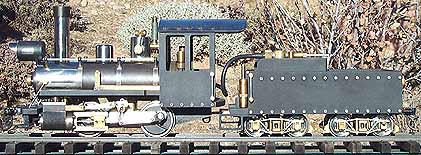
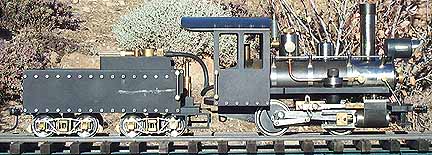


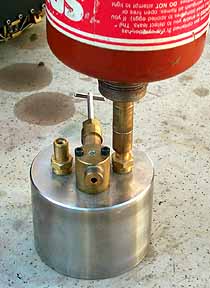
Above: The removable gas tank resides in the tender. Atop it are a pair of Shrader valves for filling, as well as the gas-control valve.
Above right: A special adapter is used for filling the tank. When not in use, it is stored on its own screw on the footplate.
Right: To fill the tank, it is removed from the tender, the adapter fitted to one of the Shrader valves, and the propane bottle pressed onto the adapter. The other Shrader valve must be briefly opened periodically while filling, so this operation must take place well away from other engines in operation.
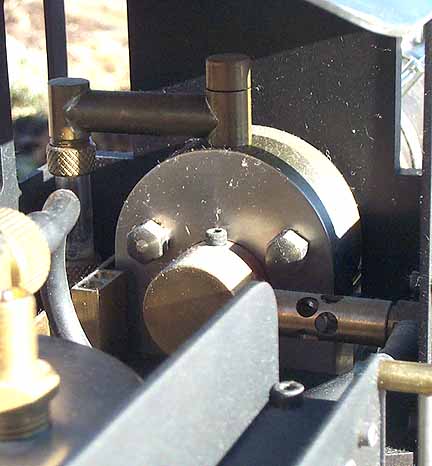
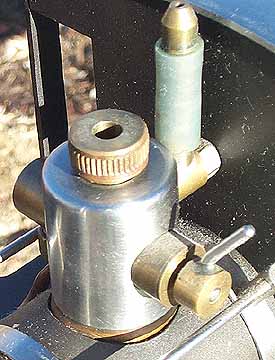
The steam dome houses the silicone-tube safety valve, a filler valve, and the throttle.
.
A water glass is fitted to the boiler, but no pressure gauge. The gas jet can be seen to the right of the burner.
.
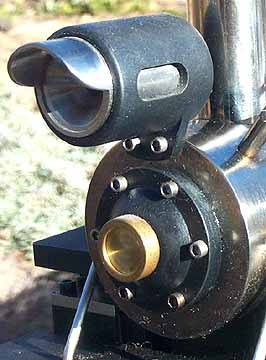


Above: Even the headlight is massive.
Above right: Valve gear and motion work are flawless on this engine. The lubricator is made from a CO2 capsule, hence its round bottom.
Right: The solid frame can be seen in this underside view.
Back to Loco of the Month home page
Back to Sidestreet Bannerworks home page
This page and its contents
Copyright Sidestreet Bannerworks, 2004